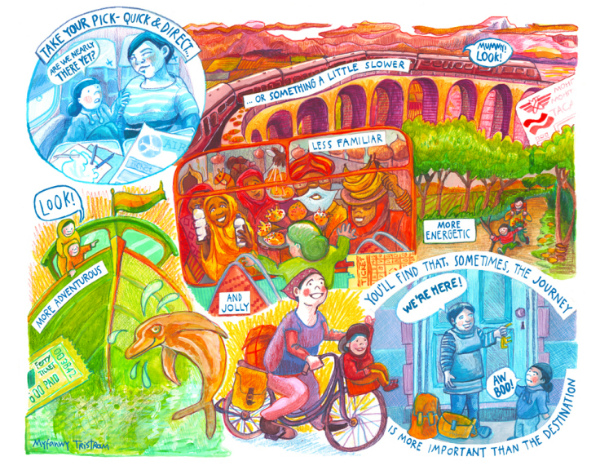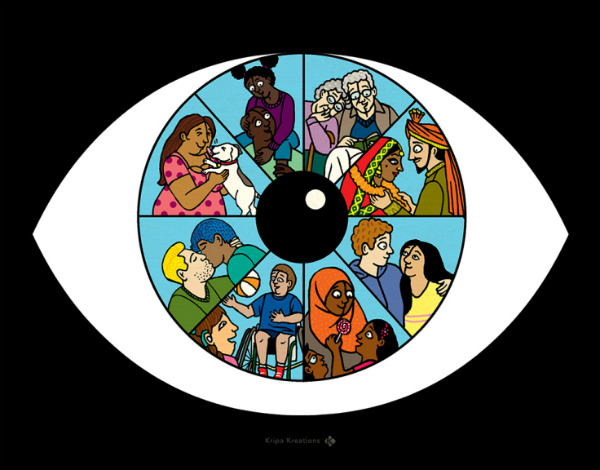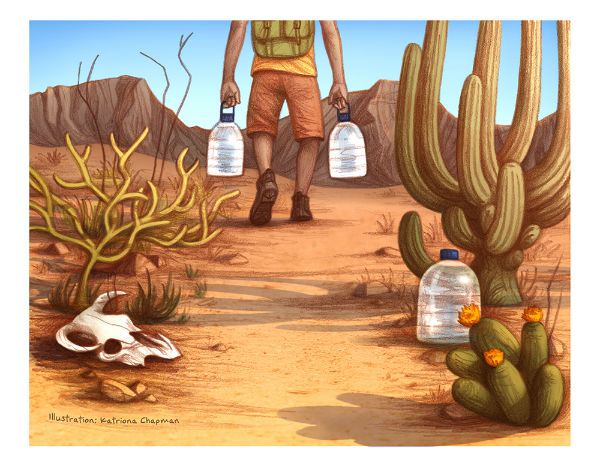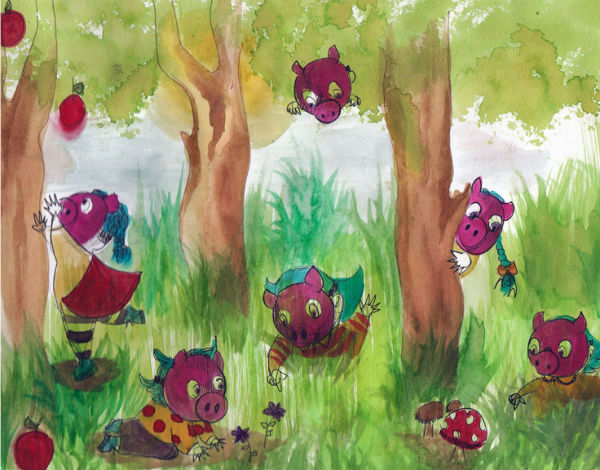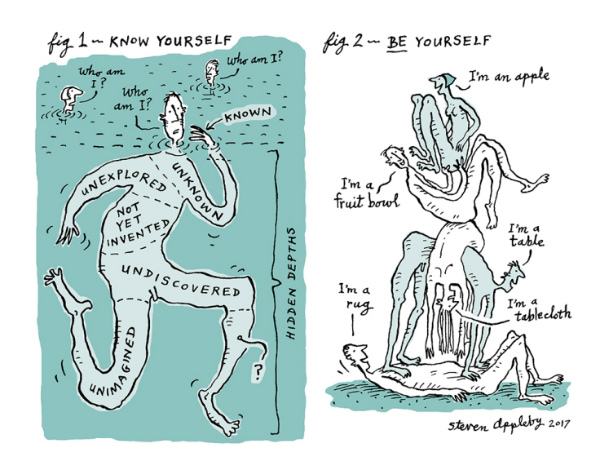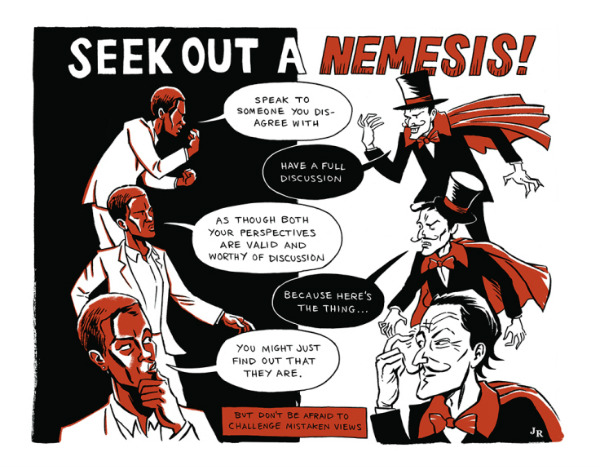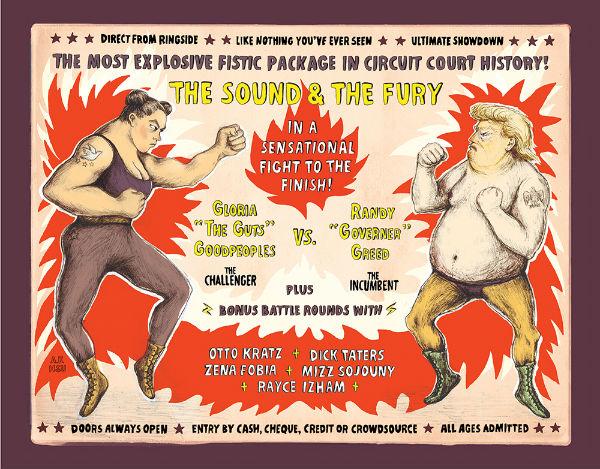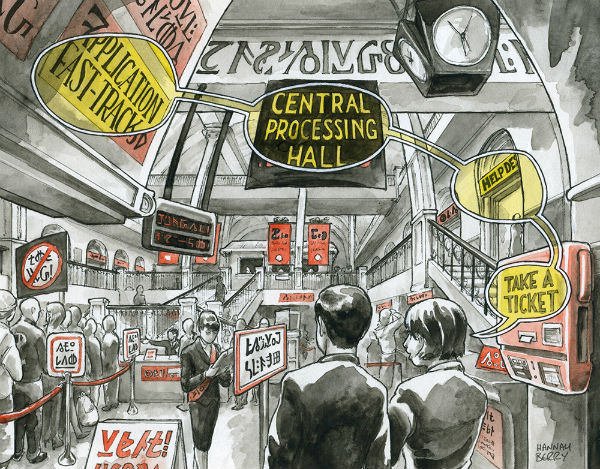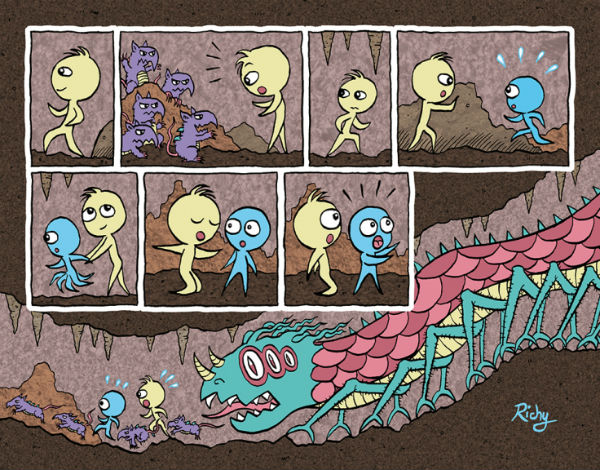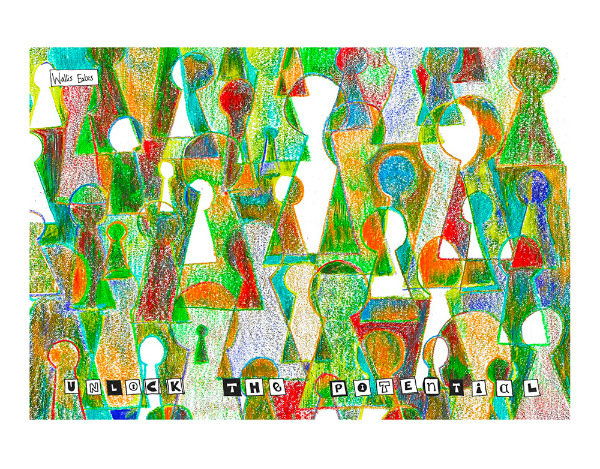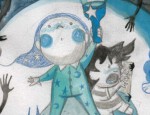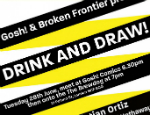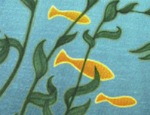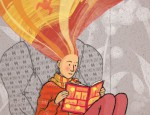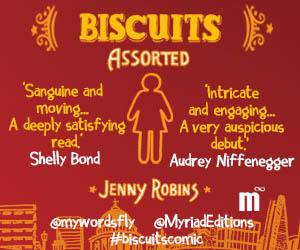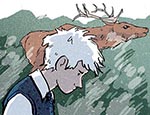
“Over 100 artists present positive political actions that anyone can take.”
That’s the soundbite that beautifully embodies the Draw the Line project – an idea dreamt up by UK small press creator Myfanwy Tristram in response to recent global events. Little did Tristram know, though, quite what she was setting into motion when she began approaching people last year to gauge interest in participation.
In the words of acclaimed graphic novelist Karrie Fransman “Draw the Line is an uplifting demonstration of what a hundred talented comic artists and activists can accomplish with blood, sweat, ink and a belief in justice and equality. We hope these actions will inspire thousands more.”
Last week the Draw the Line website launched to hugely positive reactions, featuring comics and illustration work from the likes of Dave McKean, Fumio Obata, Hannah Berry, Kripa Joshi, Steven Appleby, Rachael Ball, Roger Langridge, Una and Broken Frontier’s own EdieOP.
Over the weekend I chatted with Myfanwy Tristram about Draw the Line’s origins, the logistical considerations in putting it together, and what the future holds for the project…
GO CROSS-COUNTRY: Taking fewer flights can be a reward in itself, if you take time to enjoy the journey as well as the destination. (By Myfanwy Tristram)
ANDY OLIVER: Before we discuss Draw the Line can you give us an overview of your own comics practice and involvement in the small press community?
MYFANWY TRISTRAM: I’ve been drawing comics since about 1987 (well, since about 1973 if you include the ones I used to make for my long-suffering parents to read). Back then I was heavily inspired by Deadline: that was my main touchpoint for the concept of comics that were anything less than mainstream. When I moved to Brighton in 1991, I became involved with Erica Smith’s riot-grrl-inspired Girlfrenzy – contributing strips to the comic and to the associated events and exhibitions she set up, and also provided comics to a Canadian publisher named ‘Oh… Comics’. It’s funny to think that this was pre-email – everything was done by post! I also put out my own anthology comic called Dumb Meets Stoopid.
At some point in the mid-Nineties though, I got a proper job, a mortgage, then got married and had a kid and stopped drawing comics altogether. When I finally came back to it, the entire small press scene had absolutely exploded. That was wonderful, if a bit daunting: I felt like I had a lot to learn about where the general direction had gone. My other dominant, if ignoble thought, was that I was no longer a rarity!
In all my previous comics activity there was a feeling that so few other people were doing anything remotely similar, so the very act of making and distributing a comic was enough to make you notable. I remember appearing with Erica and a few other women comic artists in the Independent, as some kind of phenomenon! But now I was just one of thousands of women putting out self-published work: it was time to really up my game.
REPRESENT EVERYONE: If you’re an artist who includes characters in their work (from cartoonist to scriptwriter to designer), make sure that you depict all kinds of people. (By Kripa Joshi)
I started off by sharing my stuff online on my blog myfanwytristram.com. A few years later and I have over 6,000 subscribers on there, which is far more audience than I’d ever expect for my printed work – it really shows how the internet has changed everything, not just artist-to-artist, but artist-to-audience.
And then, in the last couple of years, I’ve teamed up with my friend Zara Slattery to co-publish Two Birds, a collection of our strips, and we’ve both also printed out some solo comics too. Last year we made the effort to get out to the major UK comics festivals. That, as well as the great online comics communities, has helped us feel like we’re a bit more up to speed with the current scene!
How did Draw the Line come about? What were the inspirations for it and why is it so relevant in the current socio-political climate?
I went out for a run some time last October. The Brexit referendum had happened. Calais was in the news.Trump hadn’t yet been elected but it wasn’t looking entirely impossible, and basically the news was full of the worst kind of doom. By the time I came back I’d had this basic idea.
I could see on Facebook that everyone I knew was feeling upset and disempowered. I just thought, what if I got together with a few comic artist friends and we each drew a few positive political actions that anyone could take – an action plan for the disempowered, made palatable through the joy of comics? The initial idea was to find, say, five or six artists and make a Kickstarter.
I work for the NGO mySociety, which is all about giving citizens the tools they need to effect change, so I suppose the concept wasn’t entirely out of the blue. I’m the communications manager there, so my day-to-day job is all about putting the message out that you can access your democratic rights, speak truth to power and all that.
CARRY WATER: Along the US/Mexico border, the Border Angels charity leaves jugs of water along desert migrant paths, to prevent dehydration — an all-too-common cause of death for migrants. (By Katriona Chapman)
So anyway, I came home from my run, stuck a post up on my Facebook page saying ‘is this a good idea?’ and had so many ‘do iiiit’ responses that I created a group for us to discuss it further. At some point, Kenny Penman (of Blank Slate Books) saw it and he pointed out that Karrie Fransman had posted recently asking what on earth comic artists could do in this climate.
I asked her to join the group and what a good move that was – she must be one of the best-connected people in the comics world! She invited loads of other people and before I knew it we had over 400 people in the group. That’s when I realised that it was going to be more than a small self-printed affair.
Karrie suggested that we launch online rather than in book form, as it would mean the work would get potentially more coverage, with people sharing on social media etc. That made sense and we decided to launch online as phase 1, then go on to make the book once that was done.
BE A TRUFFLE PIG: Even in the city foraging is a way to find great food. You’ll also get some exercise and fresh air, reconnect with the natural world and save money. Plus, it’s the ultimate in reducing your food-related carbon footprint. (By EdieOP)
How would you describe the philosophy and primary objectives of Draw the Line? What was the basic brief to artists?
Our tagline is “Over 100 artists present positive political actions that anyone can take”. That sums it up nicely.
The underlying brief has been that the actions are non-partisan: that means that they depict tools that are available to *anyone* who’s discontent with the way the current political scene is. At the moment of course, that landscape has swung far to the right but in theory, if it were the opposite, these democratic, campaign and protest tools would still be available to anyone who didn’t like the prevailing politics. We cover all the general tools of democracy, from writing to your MP to going on a march to even standing for election yourself.
There is another layer of actions though, which are a definite response to the current climate: actions that offer support to refugees or the homeless, that back up services that are struggling because of governmental funding cuts, or that offer understanding to minority groups such as transgender people. Those don’t feel quite so neutral, politically speaking, but they are based on a general precept of kindness to your fellow man, which I think is pretty hard for people of any political stripe to condemn.
Every artist was allocated one action to illustrate on a single page, and told it could be a strip or just one illustration. They were also asked to keep their illustrations suitable for all audiences, including kids and people from a variety of cultures. So no swearing and no graphic sex or violence.
BE WHO YOU ARE …and allow others to be who they are. BlackLivesMatter say ‘be unapologetically black’. The same can apply across all ways of being. Be who you are, unapologetically. And help others do the same. (By Steven Appleby)
Draw the Line includes acclaimed comics artists of the likes of Dave McKean, Karrie Fransman and Steven Appleby through to some of the exciting names on the indie scene making names for themselves over the last couple of years like Danny Noble, Katriona Chapman and John Riordan. How vital was it for Draw the Line to represent not just celebrated names in the field but also up-and-coming and grassroots practitioners?
So, from what I’ve said, you can see that the project began at the smaller end of the scale — the bigger names came on board later. It was great that they did! Not only do we love their work, but inevitably it was always going to mean that the project got more attention.
But bear in mind that when I first conceived of Draw The Line, getting someone like Katriona Chapman involved was my greatest ambition – literally, hers was the name I thought of, when I went through my dream-world scenarios. 🙂 I had imagined the entire thing being rooted in the world that I have made all my comics within, and being sold in places like Thought Bubble or the Lakes, where those up and coming names would give us a boost.
As the project took shape it became really clear that we had artists with a wide range of experience and skills. But that was fine: by including all the artists who submitted, we’d be adhering to our own ethos, the very actions that we were putting out there – inclusion, equality, tolerance etc. There’s no denying that the quality of the work varies but I would also say that everyone, no matter how experienced, has risen to the challenge and provided the very best of themselves. Every piece has its own worth.
We’re really glad that we have a pretty much 50/50 gender split, we have artists from the LGBTQ community, disabled artists, people of colour, and from more than 15 different countries.
SEEK OUT A NEMESIS: Speak to someone you disagree with. Have a full discussion as though both your perspectives are valid and worthy of discussion. Because here’s the thing… you might just find out that they are. (By John Riordan)
What is it about comics as a communicative tool that makes them such a powerful medium to inform, educate and share personal experience?
It’s really clear to me that comics pull people in. They think it’ll be an easy read, with pretty pictures, and then: bam!
Perhaps another influence on Draw The Line was that I saw Kate Evans and Olivier Kugler speaking at Graphic Brighton last year.
You’ve probably seen Kate’s work Threads, about going over to Calais and working in the refugee camp; Olivier’s work was new to me but instantly compelling – similarly he was bearing witness to the lives of refugees with these amazingly beautiful pictures.
If, as an artist, you can put people’s words on the page, show the conditions they’re living in – in my view, there really is no more direct route to the heart. More and more I feel like documentary comic-making is such a strong force and really important work.
HAVE YOUR DAY IN COURT: Your government should serve you. If you believe they have gone so badly astray from this path that they are doing actual harm, there is recourse: you can take them to court. (By Amber Hsu)
Can you tell us about the logistics of putting together a project like this – from curating the work through to the technical side of getting the work out to an audience? What were the particular challenges you faced as the process progressed?
Yes! If I had to give a talk (and I’d really like to if anyone’s offering!) it might be titled ‘how to use the tools of your job for a large scale comics project’. It’s basically taken a minimum of an hour’s work a day since that first Facebook post in October, and sometimes lots more, and I’ve mainly used the hour before I start my day job each workday. In the end we received 141 pieces of artwork (some artists provided 2).
As a Communications Manager, working for an organisation where we’re located all over the country, I was already familiar with a load of tools and strategies that were vital for overseeing this many people.
Here’s some of the things we used:
– Shared Google spreadsheets to collect the names, websites and email addresses of all the artists who were interested in contributing; and later to keep track of who had submitted, who had asked for an extension, etc
– Shared Google Docs to brainstorm the political actions that we’d eventually refine and then allocate to each artist
– Mailchimp to send mass mailings to all the artists and remind them of forthcoming deadlines, answer FAQs etc
– Facebook was invaluable for answering a question – that way, everyone in the group saw the answer so you didn’t have to answer the same question again and again
– Hootsuite for scheduling our social media messages
– WordPress to build the website
– One gmail account that we could delegate to everyone on the committee
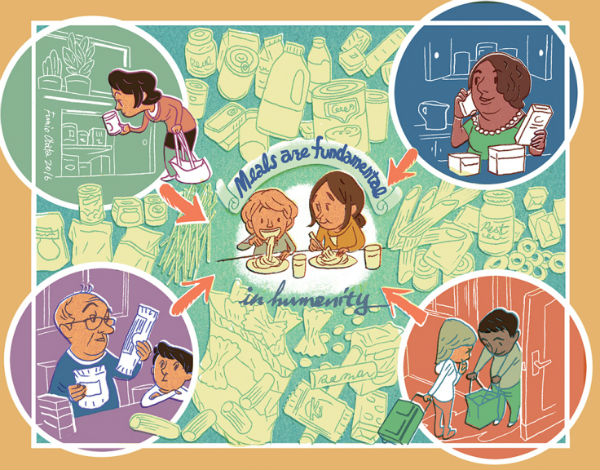
START A COLLECTION: Consult the websites of migrant aid charities and food banks to see what kind of food is needed — usually dried or tinned goods. Then ask your neighbours to help you collect them. Allocating one type of food to each street in your neighbourhood can be good — and then the competitive instinct kicks in as you see which street can come up with the most. (By Fumio Obata)
I also used a technique which we use at work to great effect: see who the most enthusiastic members of a community are, and ask them to help you run it. So on Facebook, it’s quite easy to see who is sharing your posts, commenting a lot, helpfully answering other people’s questions, etc. It’s obviously already in their nature to be helpful; they have the time and the desire to help, and the understanding of what the project hopes to achieve. And getting those people on board was one of the smartest thing I did. They were:
Karrie Fransman – made the logo, helped with networking
Graeme McGregor – helped with marketing
Simon Russell – helped format all the images as they came in
Zara Slattery – helped with admin
Martin Wright – helped with the website design
Apart from all the practical help they gave, it was also just incredibly helpful to have a bunch of people to message and say ‘I’m doing this next, shout if that’s a really stupid idea’.
The other thing that the committee really helped with was in reaching out to a whole load of charities and organisations, just to make sure that the actions we were suggesting were the ones they’d endorse. This hopefully gave us a bit of a buffer against being a load of do-gooder liberals putting out an agenda for how to live according to our own beliefs (one of my greatest fears as I fell asleep each night).
As a result, each political action links to this page where you can see the actual organisations that will help you if you want to take that action. Much as I love all the artwork, that is one of my favourite pages on the site, because it contains so many positive avenues of hope and practical activity.
INTERPRET A NEW LIFE: If you’re bilingual, your language skills could be of great help to those settling in your country. (By Hannah Berry)
What have reactions been like to the work on show and the spirit of the venture since it went live?
SO positive. It’s been incredible. The whole thing was in my head for so long that it’s been amazing – I’ve literally been walking around, saying to myself ‘People really like it!’.
The nicest thing has been that organisations such as the Fawcett Society and some refugee action charities have shown a lot of enthusiasm. An MEP has been in touch and would like to chat about the possibility of us giving a talk or maybe having an exhibition. Twitter has been a love fest. And we’re only 5 days since launch.
Is there any possibility of compiling the Draw the Line contributions in book form at any point?
Yes! As mentioned, that was the original idea and it’s still the planned phase two.
Since launch we have had interest from five different publishers, as well as an opportunity to collaborate on a self-publishing venture, so we’re weighing up all the pros and cons, but it definitely looks like it will happen. Ideally without our having to roll out all our admin skills again to oversee a Kickstarter – I have to admit I’m quite looking forward to getting some time back to draw my own comics now.
There’s still time to get in touch, if any other publishers are interested! We’d particularly like to position this in the graphic novels market. A couple of the publishers who got in touch were immediately making the assumption that comics are for young readers, which we think isn’t the right fit for Draw The Line.
RESEARCH YOUR GOOD INTENTIONS: Read up on how people prefer to be supported. Your assumptions may not be quite right. (By Richy K. Chandler)
What plans do you have for the future of Draw the Line? Have you had any thoughts about expanding its scope going forward?
The end result of all of this is that we have a thriving community of active, positive comic artists who are all keen to make change. There has been some talk about setting up as a collective which might, for example, offer comics to charities and other organisations that need them, at a cut price.
We’ve also talked about adding more comics to the website at key moments such as the next local elections in the UK or the primaries in the US.
I wondered about doing a kids’ version of Draw The Line… and we’d love to think about an exhibition. These are all just ideas at the moment, though, and I’d like to concentrate on getting the print book out before we do anything else!
I also spoke to two of the contributing artists to the project over the weekend to get their feedback on being involved. Double Broken Frontier Award-winning Karrie Fransman and Broken Frontier Award-nominated Wallis Eates give their thoughts below…
Karrie Fransman
When I saw Myfanwy’s Tweet about this project I jumped for joy. I’d just put a post up on Facebook calling for comic artists to rise up following the shock of Trump’s election and the rising nationalism and Islamophobia across the Western World. I strongly believe that in this anti-intellectual society where news is mostly consumed online, the role of the comic artists is more important than ever in communicating complex ideas is simple, engaging and empathetic ways. I really hope this comic art activism in Draw the Line provokes and inspires so much more activism on a larger scale. Now is the time to stand up and be counted!
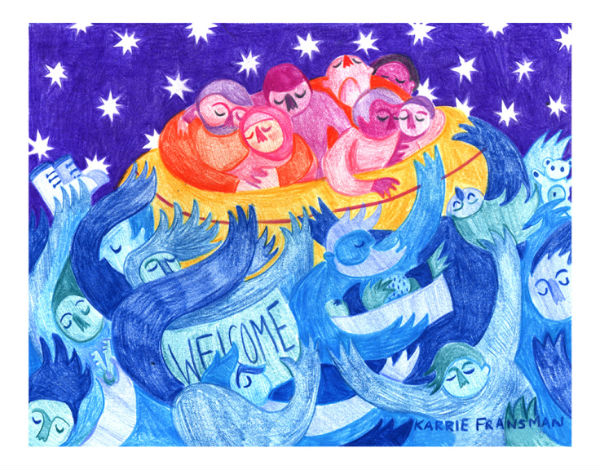
PUT OUT A WELCOME MAT: Let refugees know that they are welcome. (By Karrie Fransman)
Wallis Eates
The issues explored in this project have been a source of outrage for a long time, but with the current political landscape making explicit the deep ideological divide within our society and across the sea, there has been a rising sense of the overwhelming. On the one hand social media is good in that it offers a place of support amongst like-minded individuals, but at the same time one becomes exposed to a barrage of anger, hate, fear and despair along with all the devastating news.
This project is important because it uses these same platforms to break down all the horror into bite-size chunks, offering clean, clear-cut solutions that empower the reader and can yield real results. Draw the Line reminds you that one person can’t fix everything but, if we all set our minds to fix something that we can, things might not be as hopeless as they seem.
Comics are immediate and can say many things in one small frame. They’re the opposite of endless articles; they’re a power punch of hello, with complexity embedded in the fingerprints.
EMPLOY THE LESS EMPLOYABLE: Could you give a job to someone who would find it hard to secure work elsewhere Consider recruiting from groups such as ex-convicts – giving them less reason to return to a life of crime – or those with autism, learning difficulties or disabilities, allowing them a chance for paid work that few others may offer. (By Wallis Eates)
Visit the Draw the Line site here and follow Draw the Line on Twitter here.





